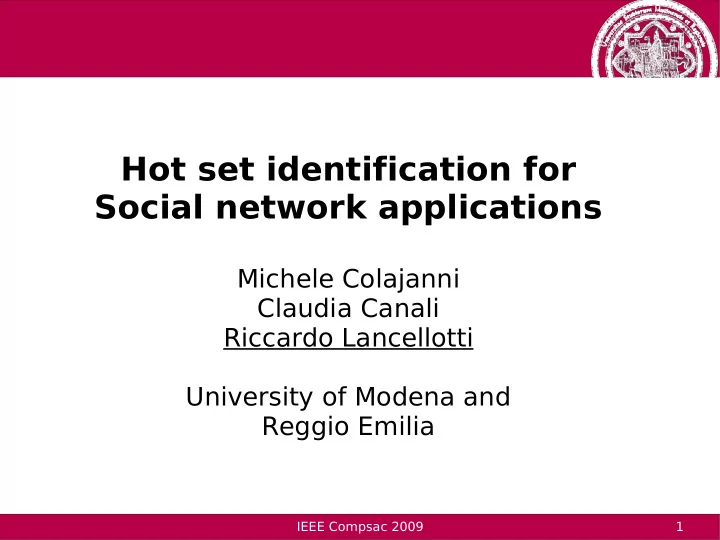

Hot set identification for Social network applications Michele Colajanni Claudia Canali Riccardo Lancellotti University of Modena and Reggio Emilia IEEE Compsac 2009 1
Future Web Scenarios ● Community-based services – Social networking: support for user interaction be the killer of future Web – Rich-media content – Presence of Mobile User access ● Workload evolution in the next five years – Computational demand will grow faster than CPU power (Moore's Law) IEEE Compsac 2009 2
Expected growth of computational demands IEEE Compsac 2009 3
Motivations for content management ● Content management – Content replication – Caching – CDN delivery – Resource pre-generation → Need to identify the ● Hot set of popular resources – Variability in workload characteristics – Rapid variations in access patterns – Workload dynamics related to social interactions → Need for algorithms providing early and fast ● detection of popular resources. → Stable performance are not an optional ● IEEE Compsac 2009 4
Proposal: Algorithms for Hot set identification ● The algorithm must identify the set HS(t) – Hot set is evaluated periodically with interval ∆t – HS(t) will receive the highest number of accesses in the interval [t, t+∆t] – HS(t) subset of R(t), working set at time t ● An algorithm must: – Estimate p r (t), where p r (t) is the popularity of resource r in interval [t, t+∆t] – Sort R(t) according to p r (t) → HS(t) is the top fraction of sorted set R(t) ● IEEE Compsac 2009 5
Proposed algorithms ● Critical task for every algorithm – Evaluation of p r (t) ● Three classes of innovative algorithms – Predictive – Social-aware – Predictive-Social ● Comparison with existing solutions IEEE Compsac 2009 6
Existing algorithms ● Focus on the time interval [t- ∆ t, t] – d r (t) is the number of access to resource r in interval [t- ∆ t, t] ● Access frequency as a measure of resource popularity – p r (t)=d r (t)/ ∆ t ● Similar to frequency-based algorithms already used for cache replacement IEEE Compsac 2009 7
Predictive algorithms ● History of past accesses to resource r represented as a time series: – D r (t)={d r (t), d r (t-∆t), ..., d r (t-(n-1)∆t)} – d r (t) is number of accesses to resource r in interval [t-∆t, t], d r (t-∆t) refer to [t-2∆t, t-∆t], ... ● Use of an EWMA model for prediction: – d r *(t,t+∆t)= γ d r *(t,t+∆t)+(1- ) γ d r (t) γ =2/n, where n is the time series length – ● Other prediction models are possible IEEE Compsac 2009 8
Social-aware algorithms ● Social network can be represented as a directed graph – Reverse contact represent the popularity of a user within the social network – User navigation exploits social links – Strong correlation between user popularity and popularity of uploaded resources → Popular users are likely to – publish popular content IEEE Compsac 2009 9
Social-aware algorithms ● Popularity estimation based on user reverse contacts – c r (t) connection degree of user that uploaded resource r – c max (t) maximum connection degree ● The model includes also the effect of resource aging – a r (t) age of resource r (time since resource upload) – p r (t)=c r (t)/(c max (t) a r (t)) IEEE Compsac 2009 10
Predictive-Social algorithms ● Most innovative class of algorithms – Merges information from two sources: – Prediction – Social information ● Need for a reliable way to merge two completely different sets of data – Different value ranges – Different probability distributions ● Use of a robust weighting function – Two-sided quartile weighted median – Given distribution P(t): – QWM(P(t))=(Q 25 (P(t))+2Q 50 (P(t))+Q 75 (P(t)))/4 IEEE Compsac 2009 11
Predictive-Social algorithms ● Merging social-aware and predictive information – p r P(t) → predictive – p r S(t) → social – δ (t) → weight ● That is: – p r (t)= δ (t) p r P(t) + (1- δ (t)) p r S(t) – δ (t)=QWM(PS(t))/(QWM(PS(t)) + QWM(PP(t))) IEEE Compsac 2009 12
Experimental setup ● Simulation based on Omnet++ framework – User population up to 20000 units – Average of 100 requests/sec – 12 hours of simulated time – ∆t=20minutes – Main metric: accuracy=|HS(t) ∩ HS*(t)|/|HS*(t)| Parameter Range Default Hot fraction [%] 5%-30% 20% Upload percentage [%] 1%-20% 5% User/resource 0.6-0.8 0.7 popularity correlation IEEE Compsac 2009 13
Performance evaluation Existing algorithms ● can be improved Predictive and social- ● aware algorithms provide significant improvement Merging prediction ● and social information provides further benefits Results are similar for ● every considered → Need to evaluate hot set size performance stability IEEE Compsac 2009 14
Sensitivity to workload dynamics Existing algorithms ● cannot cope with large amount of uploads Prediction is highly ● sensitive to upload percentage Social-aware ● algorithm is not sensitive to workload dynamics Predictive-Social ● algorithm provides stable performance IEEE Compsac 2009 15
Sensitivity to social parameters Prediction is not ● affected by social phenomena Social-aware is highly ● sensitive to the correlation between user and resource popularity Predictive-Social ● algorithm provides stable performance IEEE Compsac 2009 16
Conclusions ● Content management will be fundamental for future social network applications – Need to identify the Hot set – Must cope with novel challenges (social interaction, short resource lifespan, ...) ● Need for high accuracy and stable performance ● Three classes of algorithms – Predictive → sensitive to workload dynamics – Social-aware → sensitive to social dynamics – Predictive-Social → stable results ● Future work – Experiments with real social network traces (any help is appreciated) IEEE Compsac 2009 17
Hot set identification for Social network applications Michele Colajanni, Claudia Canali Riccardo Lancellotti riccardo.lancellotti@unimore.it University of Modena and Reggio Emilia IEEE Compsac 2009 18
Recommend
More recommend